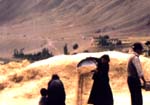


|
|
 |
| HOME | TRAVEL | TRAVELOG | ||

A Tale from Ladakh ... growing up in Little Tibet Jaideep and Suniti Mukerji
We had plans to see the ancient Buddhist monasteries of the Indus valley and then to trek in the Markha Valley on a trail that skirted the Stok Kangri peak (20,200 feet high) that overlooks the town of Leh. Now let me back track a bit here... For those of you who don't know: Ladakh or Little Tibet is a wildly beautiful desert region, high in the western Himalayan plateau. Culturally and geographically very close to Tibet, the Ladakhi kings had for centuries been subservient to the more powerful Tibetan rulers to the east. Though it is place of few resources and an extreme climate, the Buddhist Ladakhis, with their traditions of frugality and their intimate knowledge of the local environment, have not only survived but actually prospered.
Leh, the main town of Ladakh was for centuries at the centre of the trade in fine pashmina wool, once worth its weight in gold. Heavily laden yak and pony caravans brought in pashmina from Tibet, turquoise, coral and silver from Yarkand and Kashgar in central Asia, spices and fabrics from India and silk from Kashmir. The Yarkandi and Kashmiri merchants of Leh were renowned for their immense wealth. William Moorcroft and John Trebeck, two English explorers visiting Leh in 1836 were stunned to see a town of such wealth located in the midst of what was obviously arid desert land. In 1976 the first visitors were allowed into Ladakh., Increasing contact with the outside world and commercialisation of a largely rural self supporting society has resulted in arrival of the familiar problems of drunkeness, alienation and crime. The comforting fabric of old traditions and community ties has been steadily undermined. On the upside -- education, though heavily biased in favour of western urban values, has brought some measure of awareness of the outside world. Businesses have started and flourished.
And Phuntsok was to be our guide. It was our first visit to this rugged mountain desert and, led by Phuntsok, we walked along stony trails listening to stories of his childhood. And about how life in Ladakh was in the fifties when the region was still unconnected by any roads to the world outside.
Phuntsok was the youngest of three children, born of parents who lived in a village some twenty kilometers outside Leh. His father tilled a small plot of land, growing wheat and barley in the short growing season, and life had remained unchanged for centuries. Phuntsok's brother and sister, both older than him, had never been to school -- the small two roomed mud schoolhouse was only built in the mid 1960s but by then the older children were well into their teens. In summer, when the whole family was needed to work in the fields for planting, weeding and harvesting, Phuntsok had to go to school. In fact it was many years later that the Ladakhis were able to convince some city dwelling school administrator to arrange the school holidays during the harvest season so the children could help in the fields and learn from their parents. The family's fortunes brightened when the marriage of Phuntsok's beautiful older sister was arranged with a head monk -- a rimpoche -- who oversaw the affairs of some of the most important monasteries of the area. The rimpoche was a powerful figure in the local Ladakhi politics at the time, and being connected to the family by marriage, raised Phuntsok's status considerably amongst his school friends.
By the end of the twelve days spent with our cheerful and talkative guide, I thought I had learnt something of Ladakhi culture but found myself wanting to know a great deal more. We kept in touch by letter for two years. Phuntsok's invitation to his wedding provided the next opportunity to visit Leh. Photographs by Jaideep Mukerji Names have been changed to protect the identities of the persons concerned.
|
|
|
Continued
|
|
|
|
|
|
HOME |
NEWS |
BUSINESS |
CRICKET |
MOVIES |
CHAT
INFOTECH | TRAVEL | LIFE/STYLE | FREEDOM | FEEDBACK |
|